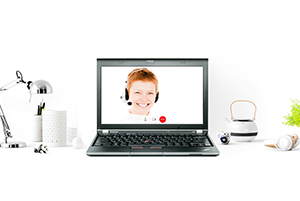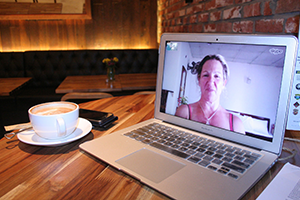 Many organisations have shifted their events, conferences, workshops and even team brainstorming sessions online to avoid the risks associated with the Coronavirus. However, as many are discovering, delivering an online workshop is not simply replicating the same content you would have used in your face-to-face workshop.
Many organisations have shifted their events, conferences, workshops and even team brainstorming sessions online to avoid the risks associated with the Coronavirus. However, as many are discovering, delivering an online workshop is not simply replicating the same content you would have used in your face-to-face workshop.
According to Anna Pino, CEO of Lighthouse Business Innovation Centre, engaging audiences online can be more challenging.
“Lighthouse runs regular business innovation workshops and seminars and when you are physically standing in front of a group of participants, you can read their expressions and body language and adjust your presentation accordingly,” says Ms Pino.
“Subtle cues allow you to adjust the pace, spend more time clarifying issues and even identify when the group needs to take a break. These cues are generally not available to you in an online workshop”.
While there are challenges associated with running online workshops, there are also many positives. For example, it is a much more affordable way to get all your stakeholders involved. This is especially true for companies with large geographically distributed teams. It can also be easier for people who have physical challenges such as auditory or visual impairments to engage effectively with the content as they can use captioning or other assistive technology or simply make the font on the screen bigger. In 2012, 1 in 2 Australians (50%) wore glasses or contact lenses1.
With online delivery being part of our reality for the foreseeable future, let’s look at some of the ways you can structure your online workshops to make them more engaging for all participants. A good starting point is to structure your workshop around the principles of Universal Design, which encourages the workshop designer to consider the diverse needs of the audience throughout the design process. Basically, Universal Design is good design, and it helps to create experiences that are accessible, usable, convenient and positive for everyone’s benefit.
1. Provide multiple methods of engagement You will need to engage with participants who have different interests, culture, opinions and level of background knowledge on the subject matter. Some of them might find the workshop topic of greater personal relevance than others. Some people look forward to learning something new, whereas others are resistant to change. Some people prefer to work alone, whereas others thrive in a group setting. When you look at all these differences you can see why one form of engagement is not going to work for everyone. Some ways you can provide variety that cater to a broad audience, include
You will need to engage with participants who have different interests, culture, opinions and level of background knowledge on the subject matter. Some of them might find the workshop topic of greater personal relevance than others. Some people look forward to learning something new, whereas others are resistant to change. Some people prefer to work alone, whereas others thrive in a group setting. When you look at all these differences you can see why one form of engagement is not going to work for everyone. Some ways you can provide variety that cater to a broad audience, include
- Using short videos or podcasts to get key points across
- eLearning games such as scenarios or simulations to encourage participants to see the issue from different viewpoints
- Online collaboration tools e.g. Miro, Mural, Stormz or Groupmap which offer whiteboarding tools and interactive brainstorming platforms
- Breakout rooms for small group work
- Online discussion groups and message boards to allow topic-specific conversations to continue before or after the workshop
- Short ‘maker’ activities and then asking participants to share a photo of their creations
2. Provide clear instructions
 According to Ms Pino when running online workshops, it is extremely important to provide clear instructions.
According to Ms Pino when running online workshops, it is extremely important to provide clear instructions.
“You want participants to feel a sense of autonomy that they know what to do and what is expected of them,” says Ms Pino.
This can mean making sure any verbal instructions are also provided as dot points on a slide or even having the facilitator demonstrate what is required. Keep in the back of your mind – ‘say it, write it, do it’ to ensure instructions benefit the auditory, visual and kinesthetic learners.
Also, ensure that video and audio material have captioning. If you don’t want to create subtitles or closed captions yourself, YouTube can use speech recognition technology to automatically create captions for your videos.
3. Build confidence in the technology
I n an online workshop, you often have the additional challenge of people needing to use technology that they are unfamiliar with. This can immediately put participants on the back foot as they grapple with getting video cameras and microphones to work. The last thing you want is a participant joining the workshop who is already stressed.
n an online workshop, you often have the additional challenge of people needing to use technology that they are unfamiliar with. This can immediately put participants on the back foot as they grapple with getting video cameras and microphones to work. The last thing you want is a participant joining the workshop who is already stressed.
“We try to be flexible about what technology platforms we use, especially if a client has a preferred one they are already familiar with. This means our facilitators need to be comfortable using everything from Zoom to Webex and Microsoft Teams,” says Ms Pino.
“We find opening meetings earlier to allow us to assist participants to sort out technology issues helps to get meetings off to a good start”.
For larger workshops and seminars, having a separate technology expert on hand to assist the facilitator should there be any technical issues can mean the difference between a workshop that stalls and one that maintains engagement.
4. Relevance and relationships
Workshops bring together a range of people and their level of engagement is directly related to how relevant they believe the content is to them and how they can see it applied to the real world.
 According to Ms Pino, in face-to-face workshops, participants will very often learn as much from their fellow participants as they will from the trainer or facilitator.
According to Ms Pino, in face-to-face workshops, participants will very often learn as much from their fellow participants as they will from the trainer or facilitator.
“Peer group interaction and seeing how different businesses or industry sectors deal with a problem, often provides the spark of inspiration a participant needs to try something different in their business,” says Ms Pino.
In an online workshop, peer interaction has to be much more carefully planned rather than left to happen spontaneously. Various online platforms provide breakout rooms, where discussions and activities can take place in small groups. Facilitators can encourage participants to share their stories which can help to create a sense of relatedness. Structured opportunities for peer-led topics can also foster peer-to-peer interaction. These tend to work best as short activity-based sessions where topics can be chunked into smaller subjects.
Ms Pino describes how her organisation uses an ‘Ignite’ format to quickly encourage diverse perspectives on a topic.
“At our Festival of Ambitious Ideas events we have up to 12 speakers each of whom has 5 minutes to provide their perspective on the topic and this is followed by an opportunity for participants to speak to individual presenters and discuss ideas in more detail,” says Ms Pino.
Strategies such as this are fast-paced and fun and help to ground the topic in the real world, making it far more relatable for participants and allowing them to make sense of complex subjects in a creative way.
5. Minimise distractions and provide opportunities for feedback
 During a face-to-face workshop, many distractions can be minimised. The facilitator can plan when breaks will occur and refreshments on the table mean you don’t have participants wandering off to get a drink in the middle of a key piece of content.
During a face-to-face workshop, many distractions can be minimised. The facilitator can plan when breaks will occur and refreshments on the table mean you don’t have participants wandering off to get a drink in the middle of a key piece of content.
It is important to minimise distractions during online workshops where many people are still working from home and balancing homeschooling children and sharing space with partners and pets also competing for attention. One way to manage this is to create opportunities for participants to have a break where they can attend to something else. The workshop can be divided into content that needs to be engaged with as a group at the same time and then the use of message boards and online collaboration tools that participants can engage with at times that suit them. Having a clear workshop structure, chunking content into short sessions, and allowing 10 to 15-minute breaks, can help to ensure that you have 100% attention when required.
Unlike face-to-face workshops where you can often see when the group is confused or someone may have questions, online workshops need clearly articulated processes for participants to provide feedback quickly. This can include online polls, chat functions or Q&A platforms such as Slido. This allows the presenter and/or facilitator to clarify any issues as they arise.
Conducting online workshops and seminars can allow you to reach your audience cheaply and accessibly, without the need for them to travel and without the additional expenses of catering and accommodation. However, online workshops are not simply face-to-face workshops delivered online. They need their own strategy, tools and methodology to ensure you have a fully engaged audience that will get the most out of the workshop.
1 https://www.aihw.gov.au/getmedia/48ee92a8-d373-4354-8df2-d664a974034f/ah16-3-15-vision-hearing-disorders.pdf.aspx



